 |
Matronics Email Lists
Web Forum Interface to the Matronics Email Lists
|
| View previous topic :: View next topic |
| Author |
Message |
fklein(at)orcasonline.com
Guest
|
 Posted: Thu Jan 27, 2011 1:56 pm Post subject: firewall penetrations Posted: Thu Jan 27, 2011 1:56 pm Post subject: firewall penetrations |
 |
|
On Jan 27, 2011, at 7:20 AM, JonSmith wrote:
| Quote: | is it considered acceptable for the electric tacho wires to pass
through the firewall via the multipin plug/ socket connector that I
have all the other low current things going through (oil press/
temp, starter solenoid control wire etc etc) or are the tacho wires
subject to interference and should thus be routed separately?
|
All,
Every so often I read a post which gets my attention and prompts me to
reconsider aspects of my build...this is one of them.
As I've posted previously, my engine is a MPEFIed derivative ot the
Sube EA81which arrived w/ a fully complete and dyno-tested wiring
harness in a nice, neat, and tidy bundle with several rectangular 15
and 27 pin Dsub connectors intended to be plugged into the ECU (shock
mounted aft of the firewall) and a small control unit to be mounted on
the instrument panel.
In the process of mounting various sensors on the engine (EGT
thermocouples, oil temp. & pressure, coolant temp. & pressure, etc.),
I have a second bundle of wires...both bundles, of course, must
penetrate the firewall in some manner.
With a fair amount of ignorance and naivety, I have been loath to mess
with the ECU bundle; consequently, I've cut a slot in the firewall big
enough to slide the 27 pin Dsub connector thru and fabbed a cover
plate from firewall material which is secured w/ nutplates w/ a hole
sufficient for the bundle. A short length of split rubber hose
surrounding the bundle is intended to protect the wires from wear
against the raw edge of the firewall and cover plate.
With regard to the sensor bundle, having been advised to avoid
connectors in the thermocouple wires leading to my EMS unit which
degrade their accuracy to some degree, I have similarly drilled the
firewall and installed a rubber grommet as shown.
A couple of photos are attached.
Prior to flight test, it's my intention daub on a bit of RTV sealant
to stop any air leakage; all of the above appears to be consistent w/
techniques used for firewall penetrations on my 1946 Stinson.
Informed comment would be much appreciated.
Please be gentle,
Fred
| | - The Matronics Europa-List Email Forum - | | | Use the List Feature Navigator to browse the many List utilities available such as the Email Subscriptions page, Archive Search & Download, 7-Day Browse, Chat, FAQ, Photoshare, and much more:
http://www.matronics.com/Navigator?Europa-List |
|
| Description: |
|
| Filesize: |
56.37 KB |
| Viewed: |
2263 Time(s) |
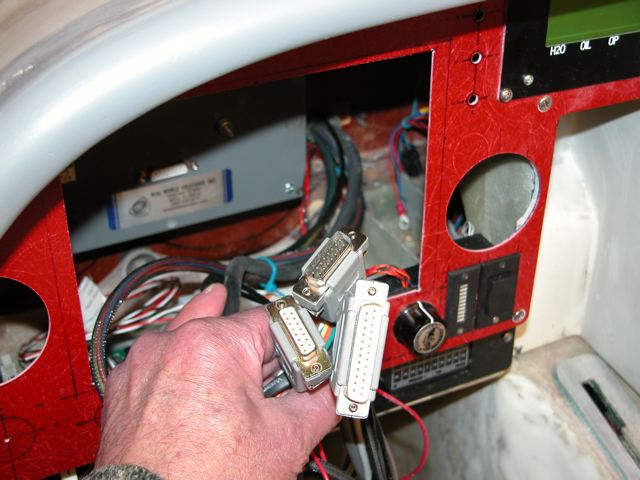
|
| Description: |
|
| Filesize: |
80.36 KB |
| Viewed: |
2263 Time(s) |
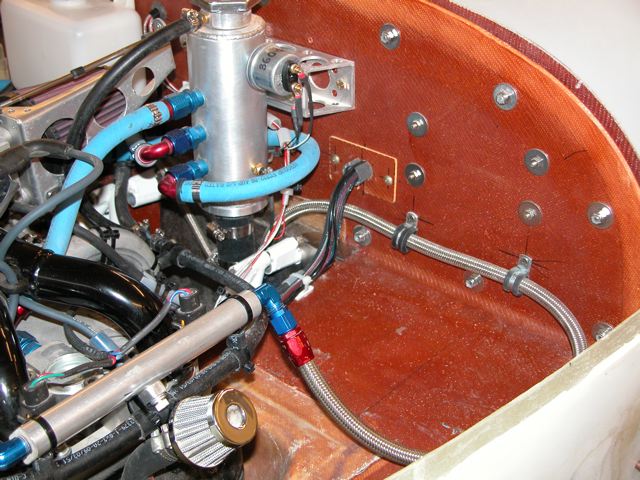
|
| Description: |
|
| Filesize: |
80.1 KB |
| Viewed: |
2263 Time(s) |
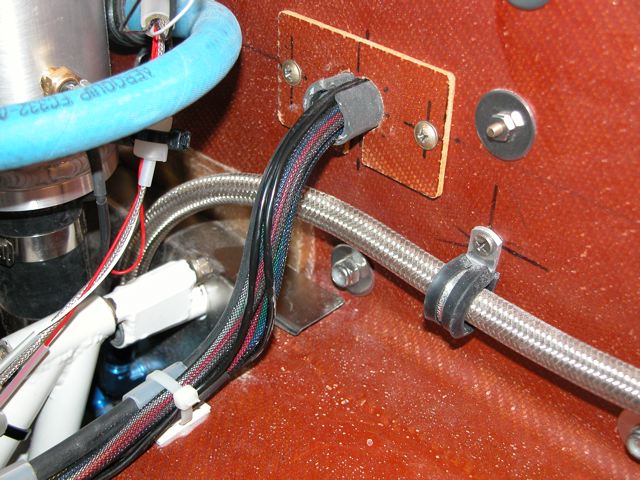
|
| Description: |
|
| Filesize: |
68.61 KB |
| Viewed: |
2263 Time(s) |
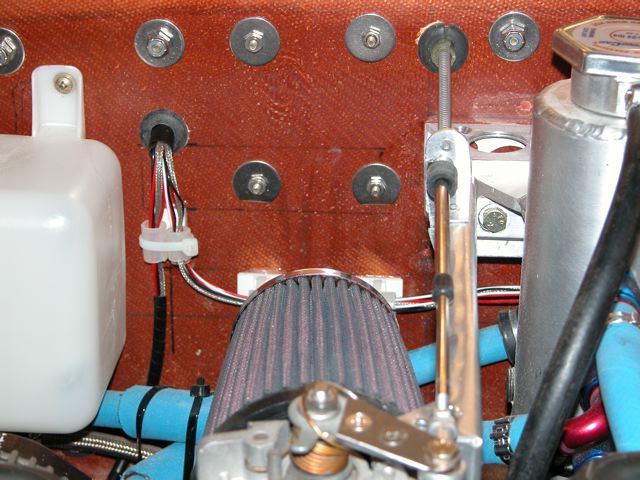
|
| Description: |
|
| Filesize: |
61.06 KB |
| Viewed: |
2263 Time(s) |
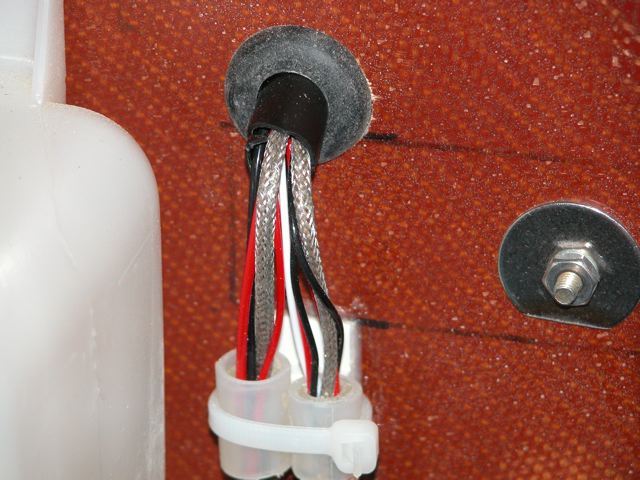
|
|
|
| Back to top |
|
 |
budyerly(at)msn.com
Guest
|
 Posted: Thu Jan 27, 2011 6:27 pm Post subject: firewall penetrations Posted: Thu Jan 27, 2011 6:27 pm Post subject: firewall penetrations |
 |
|
<?xml:namespace prefix="v" /><?xml:namespace prefix="o" /><![endif]--> Fred,
My DAR, Dennis Carley was fine with the penetrations I had on a Zenith which were similar to yours but metal of course. The Subaru was so dependent on the electrical, he asked that I consider using fire sleeve over the critical fuel injection and ignition wiring especially near the high heat areas and of course seal it all with RTV as you said, to deter fumes and flame penetration. He did not make it mandatory, but asked me to consider it because the harness was automotive wire and not mil spec aviation wire... I looked at other aircraft builder techniques and instead of running the wires through the fire sleeve, I noticed many RV builders slit the fire sleeve and only use it near the firewall and in high temp areas and not over the whole engine. Then they zip tie it... That looks nasty. To seal the slit in the fire sleeve, I recommend F4 tape and RTV
F4 tape is a self adhering (non adhesive) silicone tape developed by the military and when pulled is heat resistant and self adhering. I've used it when you forget that piece of heat shrink, and it is awesome, but somewhat expensive. See one of the vendors: http://www.rescuetape.com or just Google it.
My DAR feels like I do that if the fire is bad enough to burn up the military spec wiring, you have more problems than worrying about the insulation of the wires. If you just do, lets say, the 4-6 inches from the firewall penetration with fire sleeve and F4 tape, at least that will ensure the fire and fumes won't get through the firewall. If you have automotive wire, change it or protect it unless it is of the new high temp stuff....
As most of you know I build a large 6x12 D shaped access hole with a flange and shear web reinforcing behind the firewall and fashion a removable panel for access to more quick disconnect plugs at the rear of the instrument panel. Attached to the removable panel, I secure one or two plugs for quick disconnects. It takes me only a few minutes to pull an engine or instrument panel as I try to make everything serviceable. It takes longer to build, but if the engine or instrument panel is easy to remove, you'll benefit from it in the long run. I prefer the metal mil spec plugs as they are highly resistant to everything, but the AMP brand plastic circular plugs are commonly used in my aircraft for firewall penetrations also. They are not fire proof, but with an RTV seal in the wire securing clamp on the rear of the plug to seal it, I believe they hold up well. Like you Fred, I don't like to cut factory bundles, but I will build a transition plug to go through the firewall only because I can build a good and trustworthy plug. For instance, if the EMS plug from the engine to computer has a D Sub, I will look at it and determine if it is worth it for me to build a transition plug from the engine through the firewall rather than drill a big hole. I would like to pull the engine easily, and this means pulling the wire harness with it. Another plug is used for the firewall mounted devices. A D Sub is not fireproof nor is it strong, and so I don't use them as firewall penetrations, especially since you have to cut out the firewall and mount the D Sub to a metal panel anyway because the plug is too short to be attached to the glass. If you decide to build a D Sub firewall transition plug, the purist would glass up an insulated cover or use a small metal cup with a flange for a fireproof cover. That is overkill to me, so go with a hole and proper fire wall penetration cover and put a transition plug behind the firewall for easy panel removal..
I leave the thermocouple wires as supplied by the probe manufacturer (normally a spade), but then inside the airframe, I'll run the rest of the way to the EIS with 20 gauge mil spec wire for CHT and EGT and have had no problem. But one should continue to the EIS with the same wire (thermocouple if the type is known) to the box. Not all manufacturers supply the extra wire and I get away with using regular mil spec aircraft wire without problems from the spades supplied by the factory going to the Engine Management box. Works for me so far.
My DAR also does not like nyloc nuts anywhere on the engine. He prefers to use loctite on studs, squeeze nuts or a cotter pins and castle nuts on the engine.
Finally, the penetration hole is best sealed with a stainless firewall penetration cover. The type that has a half a hole in each half, but the two haves have a tab that actually overlaps and are secured with screws and nutplates. A grommet cut to slip on the wires along with RTV seals the hole well. Your setup looks like you have a slot which does the same thing but in the fire wall material, so protect the wires and rubber hose with a bit of fire sleeve, and seal it with RTV and go for it.
Regards,
Bud
[quote] ---
| | - The Matronics Europa-List Email Forum - | | | Use the List Feature Navigator to browse the many List utilities available such as the Email Subscriptions page, Archive Search & Download, 7-Day Browse, Chat, FAQ, Photoshare, and much more:
http://www.matronics.com/Navigator?Europa-List |
|
|
|
| Back to top |
|
 |
fklein(at)orcasonline.com
Guest
|
 Posted: Thu Jan 27, 2011 10:54 pm Post subject: firewall penetrations Posted: Thu Jan 27, 2011 10:54 pm Post subject: firewall penetrations |
 |
|
Bud...thank you for your very responsive and thoughtful post addressing my concerns...followup comments indented below.
Fred
On Jan 27, 2011, at 6:20 PM, Bud Yerly wrote:
| Quote: | Fred,
My DAR, Dennis Carley was fine with the penetrations I had on a Zenith which were similar to yours but metal of course. The Subaru was so dependent on the electrical, he asked that I consider using fire sleeve over the critical fuel injection and ignition wiring especially near the high heat areas and of course seal it all with RTV as you said, to deter fumes and flame penetration. He did not make it mandatory, but asked me to consider it because the harness was automotive wire and not mil spec aviation wire...
|
I'm not sure and have asked the engine builder, Ron Carr, of RAM Performance; he did use all Aeroquip hose and fittings on the plumbing side of things...
| Quote: | I looked at other aircraft builder techniques and instead of running the wires through the fire sleeve, I noticed many RV builders slit the fire sleeve and only use it near the firewall and in high temp areas and not over the whole engine. Then they zip tie it... That looks nasty. To seal the slit in the fire sleeve, I recommend F4 tape and RTV
F4 tape is a self adhering (non adhesive) silicone tape developed by the military and when pulled is heat resistant and self adhering.
|
Why am I not surprised to learn you endorse "F4" tape?
| Quote: | I've used it when you forget that piece of heat shrink, and it is awesome, but somewhat expensive. See one of the vendors: http://www.rescuetape.com or just Google it.
My DAR feels like I do that if the fire is bad enough to burn up the military spec wiring, you have more problems than worrying about the insulation of the wires.
|
That's nice to know...that's exactly what I was thinkin, but was unsure about how close to the razor's edge that kind of thinking was putting me.
| Quote: | If you just do, lets say, the 4-6 inches from the firewall penetration with fire sleeve and F4 tape, at least that will ensure the fire and fumes won't get through the firewall. If you have automotive wire, change it or protect it unless it is of the new high temp stuff....
|
Bud...when you say fire sleeve 4-6 inches from the firewall penetration, do you intend that the fire sleeve lines the hole of the FW penetration?...or do you intend that it ends hard against the firewall?
| Quote: | As most of you know I build a large 6x12 D shaped access hole with a flange and shear web reinforcing behind the firewall and fashion a removable panel for access to more quick disconnect plugs at the rear of the instrument panel. Attached to the removable panel, I secure one or two plugs for quick disconnects. It takes me only a few minutes to pull an engine or instrument panel as I try to make everything serviceable. It takes longer to build, but if the engine or instrument panel is easy to remove, you'll benefit from it in the long run. I prefer the metal mil spec plugs as they are highly resistant to everything, but the AMP brand plastic circular plugs are commonly used in my aircraft for firewall penetrations also. They are not fire proof, but with an RTV seal in the wire securing clamp on the rear of the plug to seal it, I believe they hold up well. Like you Fred, I don't like to cut factory bundles, but I will build a transition plug to go through the firewall only because I can build a good and trustworthy plug. For instance, if the EMS plug from the engine to computer has a D Sub, I will look at it and determine if it is worth it for me to build a transition plug from the engine through the firewall rather than drill a big hole. I would like to pull the engine easily, and this means pulling the wire harness with it. Another plug is used for the firewall mounted devices.
|
The lines to my D Subs (which will all be aft of the firewall) are plenty long enough to plug into the ECU and control module on the panel face, so I'm good there. To pull the engine, all I have to do is remove the instrument sub-panel, unplug them, and disconnect a couple of "eyes" bolted to power studs...that seems simple enough...I have so much stuff bolted to both sides of the firewall, a big D shaped access panel thru the firewall isn't in the cards.
| Quote: | A D Sub is not fireproof nor is it strong, and so I don't use them as firewall penetrations, especially since you have to cut out the firewall and mount the D Sub to a metal panel anyway because the plug is too short to be attached to the glass.
If you decide to build a D Sub firewall transition plug, the purist would glass up an insulated cover or use a small metal cup with a flange for a fireproof cover. That is overkill to me, so go with a hole and proper fire wall penetration cover and put a transition plug behind the firewall for easy panel removal..
I leave the thermocouple wires as supplied by the probe manufacturer (normally a spade), but then inside the airframe, I'll run the rest of the way to the EIS with 20 gauge mil spec wire for CHT and EGT and have had no problem. But one should continue to the EIS with the same wire (thermocouple if the type is known) to the box. Not all manufacturers supply the extra wire and I get away with using regular mil spec aircraft wire without problems from the spades supplied by the factory going to the Engine Management box. Works for me so far.
|
In my case, my EGT thermocouples came w/ 4 feet of wire ending in 1/4" long pins, so my intention is to clip the pins and wire them directly into the EMS box. The EMS has plenty of unused channels (I'll have no CHTs to measure) so I'm planning on making up some thermocouples to measure inlet/outlet coolant at both rads, along w/ inlet/out air temps at both rads...looks like I'll have a bunch more wires thru the firewall...
| Quote: | My DAR also does not like nyloc nuts anywhere on the engine. He prefers to use loctite on studs, squeeze nuts or a cotter pins and castle nuts on the engine.
|
Nor do I...the ones you see in the photo are locally purchsed SS nylocs (the ONLY ones on my airplane) to mate w/ the shock-mount studs I got from mcmaster to mount the overall instrument module to the firewall...I'll be replacing them w/ stiff nuts...I'm using castle nuts & cotter pins on the engine mounting frame.
[quote] Finally, the penetration hole is best sealed with a stainless firewall penetration cover. The type that has a half a hole in each half, but the two haves have a tab that actually overlaps and are secured with screws and nutplates. A grommet cut to slip on the wires along with RTV seals the hole well. Your setup looks like you have a slot which does the same thing but in the fire wall material, so protect the wires and rubber hose with a bit of fire sleeve, and seal it with RTV and go for it.
Regards,
Bud
[quote]---
| | - The Matronics Europa-List Email Forum - | | | Use the List Feature Navigator to browse the many List utilities available such as the Email Subscriptions page, Archive Search & Download, 7-Day Browse, Chat, FAQ, Photoshare, and much more:
http://www.matronics.com/Navigator?Europa-List |
|
|
|
| Back to top |
|
 |
budyerly(at)msn.com
Guest
|
 Posted: Fri Jan 28, 2011 5:41 am Post subject: firewall penetrations Posted: Fri Jan 28, 2011 5:41 am Post subject: firewall penetrations |
 |
|
<?xml:namespace prefix="v" /><?xml:namespace prefix="o" /><![endif]--> Fred,
You're making great progress.
It is interesting how the wires multiply.
I try to make things simple, but just add one thing and it seems like it's another 100 feet of wire.
For the fire sleeve around the wires, your rubber hose for anti-chaffe (is that a word?) is really tight in the photo I see, so I would just shorten the rubber hose up a bit and wrap that up with the fire sleeve and silicone heat tape, then RTV to seal. In practice the DARs prefer the fire sleeve be the grommet material and the end RTV'd. I still prefer a standard metal firewall penetration cover. No questions about it and it covers the hole and provides quick access. Add a dab of RTV and you are good for life.
Talk to your engine guy and see what kind of wire spec he has and which is the most critical before doing any shielding of the wires. If it is high temp wire, leave it alone.
Off to work.
Bud
[quote] ---
| | - The Matronics Europa-List Email Forum - | | | Use the List Feature Navigator to browse the many List utilities available such as the Email Subscriptions page, Archive Search & Download, 7-Day Browse, Chat, FAQ, Photoshare, and much more:
http://www.matronics.com/Navigator?Europa-List |
|
|
|
| Back to top |
|
 |
|
|
You cannot post new topics in this forum
You cannot reply to topics in this forum
You cannot edit your posts in this forum
You cannot delete your posts in this forum
You cannot vote in polls in this forum
You cannot attach files in this forum
You can download files in this forum
|
Powered by phpBB © 2001, 2005 phpBB Group
|







